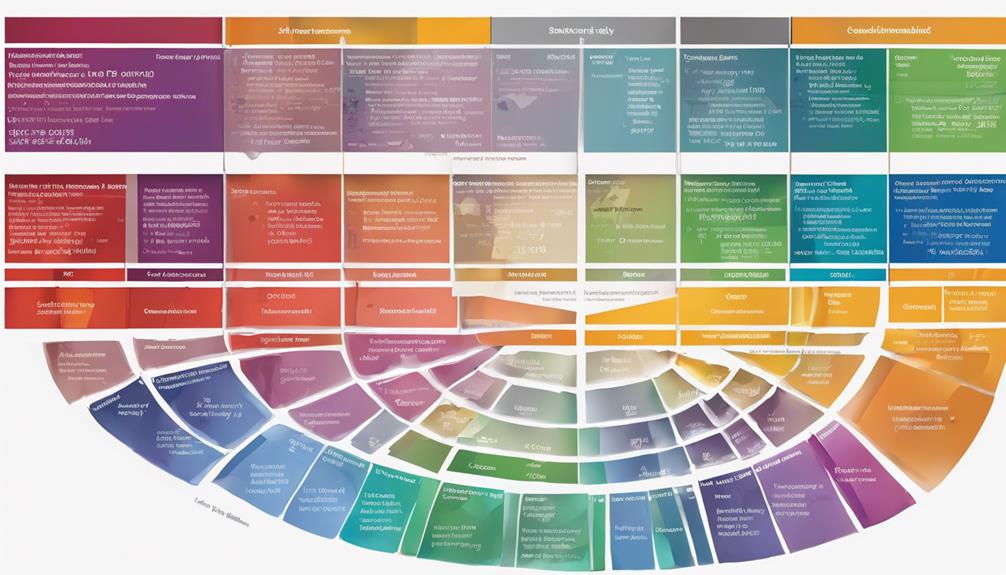Imagine a safeguard for your prescription requirements, simplifying the complex realm of drug expenses.
Medicare Part D…
Key Takeaways
- Medicare Part D requires existing Medicare coverage (Part A or B).
- Part D covers a wide range of prescription drugs, including protected classes.
- Costs vary based on drug tiers, with assistance programs available.
- Understanding coordination with other insurance is crucial for maximizing benefits.
Eligibility for Medicare Part D
To qualify for Medicare Part D, individuals must have existing coverage under either Medicare Part A or Part B. This prescription drug coverage is voluntary and provides additional assistance for those enrolled in Medicare Advantage Plans that don't already include drug coverage.
Eligibility for Medicare Part D requires U.S. citizenship or lawful presence within the country. It's important to note that enrollment in a separate Medicare drug plan isn't mandatory, but it can be beneficial for individuals seeking comprehensive prescription coverage.
The process of enrolling in a Medicare drug plan is straightforward and can be done through various channels such as the Medicare Plan Finder, plan websites, paper forms, direct plan calls, or by contacting 1-800-MEDICARE for assistance.
Understanding the eligibility criteria for Medicare Part D is essential for individuals looking to enhance their prescription drug coverage and ensure they've access to necessary medications.
Coverage Under Medicare Part D

Medicare Part D provides essential coverage for prescription drugs to beneficiaries under the Medicare program. Part D plans are designed to cover a wide range of prescription drugs, ensuring that beneficiaries have access to necessary medications. These plans include drugs in protected classes, such as treatments for cancer or HIV/AIDS, to guarantee comprehensive coverage. In addition to prescription drug coverage, Medicare Part D plans often work in conjunction with other parts of Medicare, such as Part A and Part B, to offer more comprehensive health care services. It is important for beneficiaries to understand how their prescription drug needs are addressed alongside services provided under Medicare Part A coverage details, which include hospital stays, skilled nursing facility care, and certain home health services. By coordinating coverage across these different parts of Medicare, beneficiaries can ensure they receive the care they need, both in and out of the hospital.
Each Part D plan maintains a formulary that outlines the covered drugs and associated costs. To promote coverage diversity, plans are required to offer at least two drugs per drug category. Beneficiaries can optimize their prescription drug spending by opting for generic drugs over brand-name medications through their Part D coverage.
Enrollment Process for Medicare Part D
The enrollment process for Medicare Part D involves voluntarily joining a Medicare drug plan, requiring eligibility through Medicare Part A and/or Part B. Beneficiaries can choose Medicare drug coverage through various enrollment channels such as the Medicare Plan Finder, plan websites, or direct calls.
To enroll in a Medicare Part D plan, individuals must be U.S. citizens or have lawful presence. There are different enrollment methods available, including using paper forms or contacting 1-800-MEDICARE. When enrolling, it's crucial to provide your Medicare number and coverage start date.
Using resources like the Medicare Plan Finder can assist in comparing and selecting the most suitable Part D drug plans. Understanding the enrollment process is vital for individuals seeking to access prescription drug coverage through Medicare Part D efficiently and effectively.
Understanding Costs of Medicare Part D

Understanding the cost structure of Medicare Part D involves navigating through various phases with differing out-of-pocket expenses and potential financial assistance options. When delving into the costs associated with Medicare Part D, it's essential to consider the following key points:
- Varied Out-of-Pocket Costs: Part D plans entail different stages with varying out-of-pocket expenses, including deductible, initial coverage, coverage gap, and catastrophic coverage phases.
- Formulary Tiers: Beneficiaries may encounter coinsurance or copayments for prescription drugs, with costs contingent on the drug's tier within the formulary.
- Inflation Reduction Act Impact: The Inflation Reduction Act has influenced Part D costs and benefits, leading to alterations in the standard benefit parameters for 2024.
- Low-Income Subsidy: Part D enrollees with limited incomes can qualify for assistance through the Low-Income Subsidy (LIS) program, offering support with premiums and cost-sharing.
- Premium Variations: The average monthly premium for a Medicare Part D plan in 2024 stands at $34.70, subject to fluctuations based on the specific plan and geographic location.
Coordination With Other Insurance Plans
How can Medicare Part D interact with other insurance plans like employer or union coverage? Understanding the coordination of benefits is crucial when considering how Medicare Part D drug coverage fits in with existing coverage from an employer or union health plan.
It's essential to identify which insurance plan serves as primary and which serves as secondary coverage to ensure that you maximize your benefits and minimize out-of-pocket costs.
Joining a Medicare drug plan can have an impact on other insurance, so assessing how Medicare Part D interacts with your existing coverage is key.
Whether you have Medicare Advantage Plans, employer, or union health coverage, navigating the coordination of benefits when it comes to Medicare Part D is vital to making informed decisions about your healthcare.
Frequently Asked Questions
What Is Medicare Part D and How Does It Work?
Medicare Part D functions as a prescription drug coverage program for Medicare beneficiaries. It operates through approved private insurance companies and helps cover the costs of various medications.
Beneficiaries can select standalone Part D plans or opt for Medicare Advantage plans that include drug coverage. These plans have formularies outlining covered drugs and cost-sharing structures like copayments and deductibles.
Do I Have to Pay for Medicare Part D?
We do have to pay for Medicare Part D, as it typically involves premiums, deductibles, copayments, and coinsurance for prescription drug coverage. The costs can vary based on the specific plan, location, and income level.
Some beneficiaries may also have to pay an additional Income-Related Monthly Adjustment Amount (IRMAA). However, low-income individuals may qualify for Extra Help to reduce or eliminate these costs, making it more affordable for them.
What Is the Average Monthly Cost of Medicare Part D?
The average monthly cost of Medicare Part D in 2023 is $33.19, with variations depending on the plan and location. Beneficiaries can choose from a range of plans offering different coverage and costs.
Low-Income Subsidy recipients may qualify for assistance, reducing their out-of-pocket expenses. Factors like drug usage, formulary coverage, and demographics can influence plan costs.
It's essential to consider these factors when selecting a Part D plan that best fits your needs.
What Is the Difference Between Medicare Part D and B?
The difference between Medicare Part D and Part B lies in their coverage focus. While Part B includes outpatient services and some prescription drugs, Part D is solely dedicated to covering prescription medications.
Part D plans are offered by private insurance companies approved by Medicare, providing various coverage options. It's crucial to understand these distinctions to make informed decisions about your healthcare coverage needs.
Conclusion
In conclusion, Medicare Part D offers valuable prescription drug coverage for eligible individuals. Remember, 'an ounce of prevention is worth a pound of cure.'
By enrolling in Part D and understanding the costs and coverage options available, beneficiaries can proactively manage their healthcare needs and potentially save money in the long run.
Make informed decisions about your medication coverage to ensure you have access to the treatments you need.









